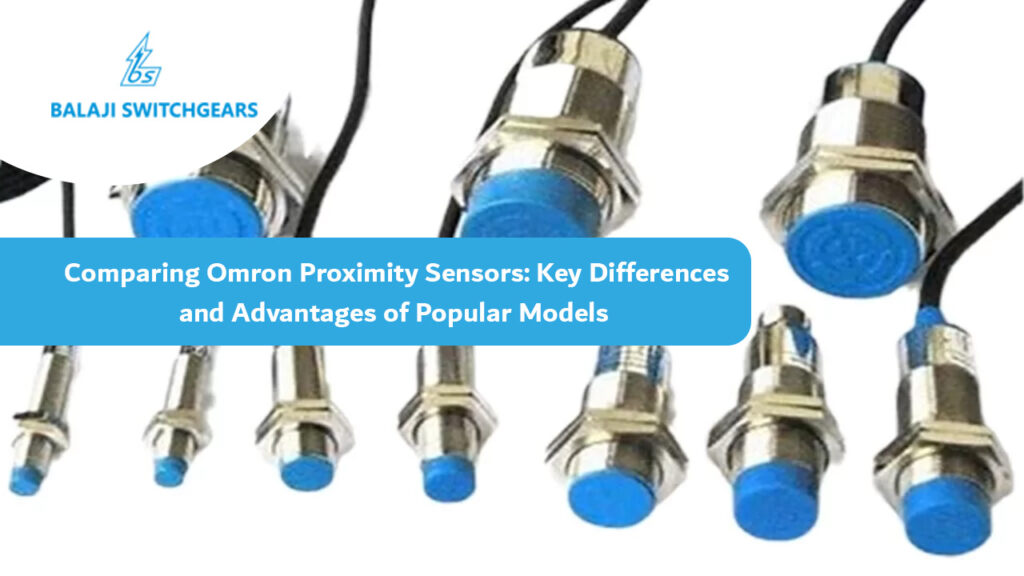In industrial automation and control systems, sensors play a pivotal role in ensuring seamless operation and precise detection. Among the leading names in sensor technology, Omron Proximity Sensors stand out for their reliability, accuracy, and adaptability across diverse applications. Whether you are new to automation or seeking an upgrade, understanding the various Omron Proximity Sensor types can help you select the right solution for your needs.
This blog explores the key differences and advantages of popular Omron Proximity Sensors, shedding light on how they can elevate your operations.
What is an Omron Proximity Sensor?
An Omron Proximity Sensor is a device that detects objects without requiring physical contact. These sensors use electromagnetic fields or infrared radiation to identify objects within a specific range. Known for their durability and precision, Omron Proximity Sensors are used in applications ranging from industrial automation to quality control.
Key Types of Omron Proximity Sensors
Omron offers a wide variety of proximity sensors, each designed for specific needs. Here are the main Omron Proximity Sensor types:
- Inductive Proximity Sensors
- Working Principle: These sensors detect metallic objects through electromagnetic induction.
- Applications: Commonly used in manufacturing lines, assembly systems, and robotic automation.
- Advantages: Highly durable, resistant to dust and dirt, and capable of operating in harsh environments.
- Capacitive Proximity Sensors
- Working Principle: These sensors identify both metallic and non-metallic objects by measuring changes in capacitance.
- Applications: Ideal for detecting liquids, plastics, and granular materials.
- Advantages: Versatile and suitable for applications requiring sensitivity to non-metallic materials.
- Photoelectric Proximity Sensors
- Working Principle: These sensors use light (infrared or visible) to detect objects.
- Applications: Widely used in packaging, conveyor systems, and safety barriers.
- Advantages: Long detection range, suitable for transparent or colored objects, and unaffected by target materials.
- Ultrasonic Proximity Sensors
- Working Principle: These sensors use ultrasonic waves to detect objects.
- Applications: Common in liquid level monitoring, object positioning, and distance measurement.
- Advantages: Excellent accuracy over long ranges and capable of detecting irregularly shaped objects.
Comparing Key Features of Popular Omron Proximity Sensors
Each Omron Proximity Sensor type offers unique features tailored to specific applications. Here’s a closer look at their key attributes:
| Sensor Type | Detection Range | Material Sensitivity | Best Suited For |
| Inductive | Short to medium | Metallic objects | Industrial automation and robotics |
| Capacitive | Short to medium | Both metallic and non-metallic | Material handling and liquid detection |
| Photoelectric | Medium to long | Transparent and opaque objects | Conveyor systems and packaging |
| Ultrasonic | Long | All materials | Level measurement and object positioning |
Each of these sensors is designed to operate efficiently in challenging industrial conditions, offering dependable performance and minimal maintenance requirements.
Advantages of Omron Proximity Sensors
- High Precision
Omron sensors are known for their accurate detection capabilities, reducing errors in automation systems. - Durability
Designed to withstand extreme environments, Omron Proximity Sensors deliver consistent performance even in the presence of dust, moisture, and vibrations. - Versatility
The wide range of sensor types ensures there is an Omron solution for almost any application, from detecting tiny objects to monitoring large distances. - Easy Integration
With user-friendly designs and compatibility with standard automation systems, Omron sensors are simple to install and configure. - Cost-Efficiency
While offering advanced features, Omron sensors are competitively priced, making them an excellent investment for businesses of all sizes.
Applications of Omron Proximity Sensors
Omron Proximity Sensors find applications across various industries, including:
- Manufacturing: For detecting parts, monitoring assembly processes, and ensuring safety in operations.
- Automotive: In vehicle assembly lines, robotic systems, and quality inspection.
- Food and Beverage: To monitor conveyor lines and ensure hygienic production standards.
- Logistics: For tracking packages, monitoring inventory, and ensuring precise sorting.
- Pharmaceutical: In automated packaging and quality control systems.
Why Choose Omron Proximity Sensors?
With decades of experience in automation technology, Omron has earned a reputation for producing world-class sensors that deliver unmatched performance. From ensuring operational efficiency to enhancing safety, Omron Proximity Sensors are a trusted choice for industries worldwide. Their combination of reliability, accuracy, and versatility makes them a standout solution in modern automation.
Conclusion: Partner with Balaji Switchgears for Expert Solutions
Choosing the right Omron Proximity Sensor can significantly impact the efficiency and reliability of your automation systems. Whether you need precision in manufacturing or versatility in logistics, Omron sensors offer solutions tailored to your needs.
At Balaji Switchgears, we pride ourselves on providing high-quality products and expert guidance to help you make informed decisions. As a trusted supplier of Omron Proximity Sensors, we are committed to supporting your automation goals with top-notch solutions and exceptional service.
For industry-leading sensor solutions and expert advice, trust Balaji Switchgears. Contact us today to explore our extensive range of Omron Proximity Sensor types and find the perfect fit for your application.

